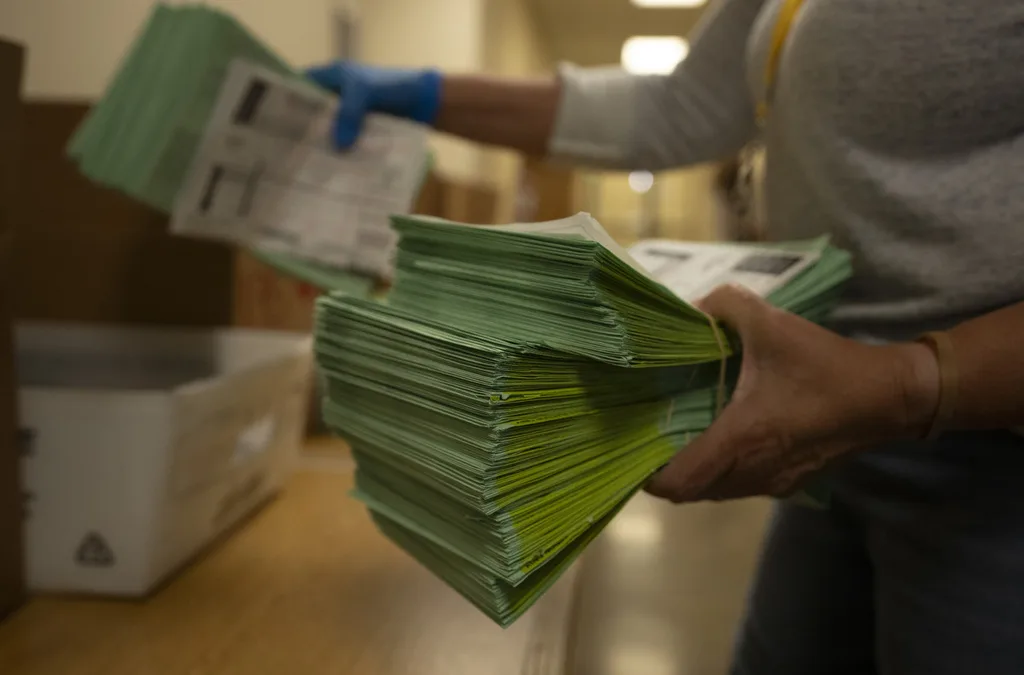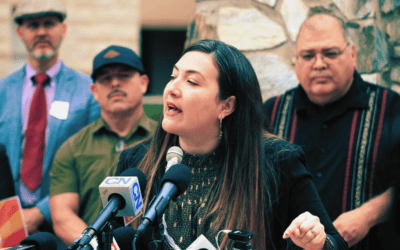PHOENIX – In a South Phoenix neighborhood of light colored townhomes and neat little front lawns, some of the roads are coated in a light gray sealant. The reason? To see whether it can slow rising temperatures in a fast-warming city.
Over the past year, the city has studied the efficacy of this reflective sealant meant to reduce the absorption of heat in the urban climate, a phenomenon known as the heat island effect. The testing is far from over, but initial findings suggest the treatment may help effectively reduce temperatures.
Alyska Wagner and her husband, Terry Lester, live near Vineyard Road and 40th Avenue, one of eight locations in Phoenix used for the experimental cool pavement sealer, and they have enjoyed what they described as a noticeable difference in the temperature since this sealant was applied. So noticeable, in fact, that Wagner had to pause to remember the kind of heat that “just wasn’t there anymore.”

Most Phoenix residents can’t relate.
“It’s cooler out walking the dogs,” Wagner said. “You don’t feel the heat radiating from it, as opposed to like a parking lot.” The couple also noticed the nighttimes felt cooler, which is a significant component of the project’s goal of reducing heat absorption.
Addressing Extreme Heat
Asphalt, concrete buildings, and other infrastructure retain heat from the sun and re-emit it. The reflective pavement reduces the amount of heat absorbed, which then lowers the amount of heat emitted at night that pushes up nighttime temperatures. This is especially important given that Phoenix is one of the fastest-warming cities in the country.
From 1970 to 2018, Climate Central found the city’s temperature increased by 4.35 degrees Fahrenheit. Heat-caused deaths in Arizona also rose from 83 in 2015, to 313 in 2020, according to the Department of Health and Safety. Addressing excessive heat, which is the number one weather-related killer in the United States, has become a focus of city officials.
The pilot project is a partnership among Arizona State University researchers, the Phoenix Street Transportation Department, and the city’s Office of Sustainability.
RELATED: Biden Administration Launches Effort to Protect Outdoor Workers From Heat-Related Illness
Heather Murphy, a spokesperson for the Street and Transportation Department, described the sealant as a “sunscreen for the roads.”
The cool pavement is a light gray, nontoxic asphalt treatment that was applied to 36 miles of roadways around the city and the lot at Esteban Park at 33rd Street and Roeser Road.
“The testing showed that the material is performing as designed, resulting in lower surface temperatures and less heat retention,” Murphy said.
The study showed the surface temperatures during afternoon hours averaged 10.5 to 12 degrees Fahrenheit lower than that of traditional asphalt, while subsurface temperatures were lowered by 4.8 degrees.
Similar Results in Other Cities
Phoenix isn’t the first city to try this sealant. Los Angeles began testing in 2015. Kristen Pawling, the sustainability program director in the Los Angeles County Chief Sustainability Office, saw similar results in that city’s cool pavement studies, and she believes the treatment will have lasting effectiveness. LA used satellite imagery to assess heat conditions and found air temperatures in neighborhoods treated with the cool pavement were lower than areas that didn’t have the treatment.
“It’s really cool,” she said of the satellite thermography, with no pun intended.
Los Angeles has continued testing and expanded application of the sealant. On Oct. 4, LA officials announced a plan to add 60 miles of cool pavement and 2,000 trees in a new phase of the Cool Streets program.
Effects on Pedestrians
The Phoenix study also found that the human experience of heat exposure during the afternoon hours was actually 5.5 degrees higher because of the reflected sunlight, although that temperature might be less alarming than it sounds.
To measure how pedestrians, outdoor workers, and unsheltered people experience heat, researchers enlisted the help of MaRTy, a meteorological device developed at ASU. Researchers wheel the robot around in a cart to detect shortwave radiation, such as sunlight, and longwave radiation, which is heat emitted from surfaces. The name MaRTy comes from its function of measuring mean radiant temperature.
Jennifer Vanos, an Arizona State University researcher and co-author of the cool pavement study, said the measurements don’t necessarily mean the roads turn up the heat on pedestrians.
“No one is walking down the middle of the street in the middle of the day,” she said.
The heat coming off the cool pavement is comparable to walking on a concrete sidewalk, Vanos said, and there is no increased concern for heat-related illness.
But the positive results do not make it a blanket solution to address rising heat in the city. The locations that the cool pavement is applied will influence how well it works.
“Where people enjoy time outdoors in neighborhoods is where it is most likely to be used,” Murphy said. “Areas with less shade and fewer buildings where it would be more useful.”
More Testing Needed
The project has a long way to go. But Vanos and Murphy remain optimistic about future studies. Vanos said one milestone in testing will be to see whether the gray asphalt sealant lasts as long as traditional black sealants.
A second milestone will be the effects of less thermal stress on the roads.
“Understanding if this helps with pavement preservation because subsurface temperatures are reduced,” Vanos said.
And her final key question: “How long will it remain reflective?”
Murphy said because typical seal coats last five to seven years, more testing is required. Phoenix also will evaluate what Murphy and Vanos referred to as “cool pavement 2.0”—a darker but more reflective asphalt sealant.
The darker gray could be a key factor for residents for multiple reasons. Wagner and Lester said that early on, the change in road color created slightly bothersome glare when driving.
RELATED: Phoenix Population Keeps Growing as Climate Danger Rises
Pawling experienced the same issue in sunny Southern California. “I walked on some of the lighter ones and you definitely want to put on your shades,” Pawling said.
The color darkened over time, but that doesn’t mean it looked better. “The tire marks made it look dirty,” Lester said, adding with a chuckle that it “aged well.”

How well it actually ages is important to researchers. The study showed a reduction in reflectivity over time, which is why monitoring the durability and longevity will be vital to understanding whether the treatment is a viable heat mitigation project. It’s especially important to determine whether benefits offset the extra cost.
The cool seal is slightly more expensive than traditional seal coats. During a video presentation of the results, Rubben Lolly, a special projects administrator for the Street and Transportation Department, said it’s a matter of cents more per square yard. He also expressed confidence that the lifecycle benefits will outweigh the additional costs.
Wagner and Lester didn’t take long to answer whether they supported the project.
“If it’s effective, yeah, we encourage it,” Wagner said. “We noticed a difference, and it’s especially nice with pets.”
Looking for the latest Arizona news? Sign up for our FREE daily newsletter.

He said what? 10 things to know about RFK Jr.
The Kennedy family has long been considered “Democratic royalty.” But Robert F. Kennedy, Jr.—son of Robert F. Kennedy, who was assassinated while...

Here’s everything you need to know about this month’s Mercury retrograde
Does everything in your life feel a little more chaotic than usual? Or do you feel like misunderstandings are cropping up more frequently than they...

Arizona expects to be back at the center of election attacks. Its officials are going on offense
Republican Richer and Democrat Fontes are taking more aggressive steps than ever to rebuild trust with voters, knock down disinformation, and...

George Santos’ former treasurer running attack ads in Arizona with Dem-sounding PAC name
An unregistered, Republican-run political action committee from Texas with a deceptively Democratic name and ties to disgraced US Rep. George Santos...




